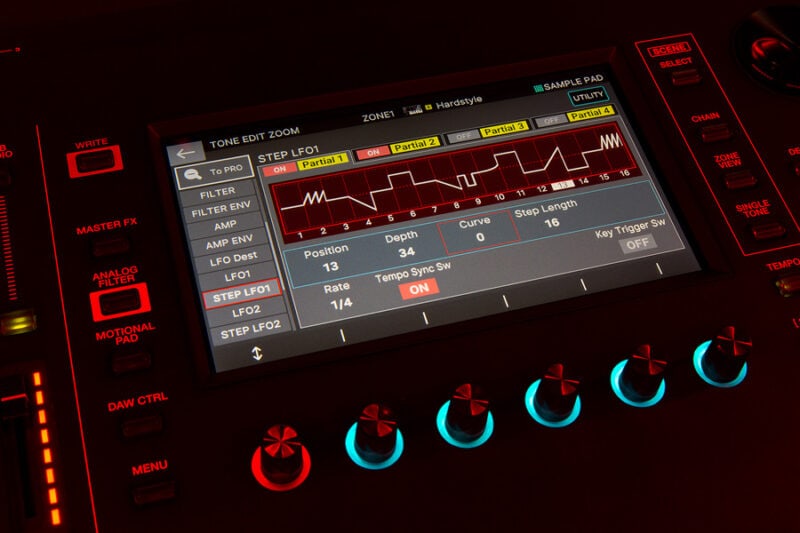Few digital pianos manufacturers offer as diverse and as innovative an assortment of digital piano tone engines as Roland. This isn’t too shocking given Roland’s 50-year history of building cutting-edge electronic musical instruments, but it’s nonetheless still impressive to see the quality and standard they’ve been able to maintain for such a long time.
Today, Roland offers 4 distinct piano tone engines across their lineup of digital pianos; the V-Piano modeling, SuperNATURAL sample-based engine, the PureAcoustic modeling engine, and finally the ZEN-Core Synthesis System.
In today’s article and companion video, we’ll be doing a side-by-side comparison of all 4 engines, covering the exact differences and features of each engine. Whether you’re simply curious and want to geek out with us on this topic, or actively shopping for a digital piano and are trying to narrow down your options based on your needs, this should be a fun and helpful comparison.
Roland Tone Engine – Background

Roland is a big player in the digital piano space, to put it lightly. With a full lineup of home digital pianos, stage pianos, portable digital pianos, workstations and synths, Roland’s instruments are popular with beginners to the most seasoned professionals, and everything in between.
We’ve covered pretty well every 88-key model that Roland makes on our YouTube channel and blogs, and in the comments of our videos, we’ve been receiving a lot of technical questions from people looking for some clarity regarding the different Roland sound engines. So we figured, why not address these questions in a single comprehensive video and blog?
To demo the various piano sound engines, we’ll be using a Roland FANTOM-8 which is loaded up with both the ZEN-Core Sound, as well as the V-Piano modeling engine. Then we have a Roland FP-30X which employs the latest version of their sample-based SuperNATURAL Piano engine with the new Behavior Modeling Core sound chip, and finally a Roland FP-90X and its PureAcoustic modeling engine.
With that in mind, we’ve gone ahead and played through all four engines side-by-side, and if you’d like to hear playing examples, you’ll definitely want to check out the video.
Comparison Format
For the purposes of our comparison, all three of these instruments (and all four patches) were recorded through analog stereo inputs into the same audio interface, with their piano sounds left untouched to keep this comparison as objective as possible.
We started off with the V-Piano on the FANTOM-8, with the default grand piano sound which is named Stage Grand, before cycling through a few others. By the way, these are exactly the same presets you’ll find on the RD-2000 stage piano.
From there, we switched over to the ZEN-Core and it’s Acoustic Pop Piano 1, which you can also find over on the RD-88, again before testing out some others. After that, we moved to the SuperNATURAL engine with its core Concert Grand piano and a couple of variations before finishing off with the PureAcoustic engine’s default Concert Grand Piano sound over on the FP-90X and a few variations.
With that out of the way, let’s move on to our musical observations.
Musical Observations

V-Piano & PureAcoustic
When we say that the V-Piano and PureAcoustic engines are modeling based, this means that the tone in each case is 100% generated via a series of complex algorithms, as opposed to a sample-based engine which plays back a recording of a real acoustic piano.
Clarity
It was immediately apparent to us that the two cleanest and clearest piano sounds were coming from these two modeled engines.
There’s no degradation, compression, or loss of clarity in any part of the sound, whether you’re talking about the transients right at the beginning of the attack of the note, the sustain, or the higher upper partials.
Both of these engines also offer limitless polyphony on their acoustic piano patches.
Tonal & Dynamic Range
Between these two engines, however, there’s quite a big difference in the dynamic response and overall sense of tonal range. With the V-Piano, there’s a ton of different color out of all of the different models, but within any specific model, the tonal variance from soft to loud is actually a little bit narrower.
Over on the PureAcoustic, there’s a broader range of character within any given patch, with more potential for nuance and intimacy. And this makes sense when you think about it since the PureAcoustic engine is so far being featured on Roland pianos geared more towards solo piano performance and practice. It also happens to be paired extremely well with the Roland PHA 50 action featured in the FP-90X.
The V-Piano on the other is generally featured on instruments where studio recording might be more expected, and in that case, it’s likely going to be better for recording purposes to have a piano tone with a very defined character as opposed to one with more variation.
So, if we were going to have to pick one and use it for every possible application, the V-Piano would probably be the pick due to its larger variety between patches. The PureAcoustic would be the choice if you were looking for the best all-around option for solo piano gigs and practice.
SuperNATURAL Engine
Moving over to the SuperNATURAL engine, we’re now shifting to a sample-based engine that utilizes some added synthesis to round out the sound.
Brightness
The first thing we noticed is that the character of the sound here is a lot brighter than what we were hearing over on the modeled engines. In the low-volume ranges you can actually make out a sense of air and space around the piano sound that’s coming from the fact that we’re hearing a recording of a real recording.
There’s definitely more clarity, brightness and overall dynamic range from the PureAcoustic engine, but the characteristic brightness we’re getting here will appeal to certain people.
Analog
We’re also getting a stronger sense of analog sound coming from the SuperNATURAL engine, and this is probably simply due to the engine being built around a real recording. There are just certain aspects of piano sound, particularly the natural imperfections that occur in acoustic instruments, that are hard to replicate at this point with modeled engines.
Even the very best modeled engines have some trouble with this. Certainly, the most complex VST engines give you the ability to tweak and synthesize the sound design by adding those imperfections to some degree, but you really need to spend serious time under the hood to do so.
ZEN-Core Synthesis System

Next up is the ZEN-Core engine, and it’s important to understand that it is the only one of the four engines we’re looking at today which is not built as a specialized acoustic piano engine. Nonetheless, here are some of our thoughts on the ZEN-Core.
Modern Synthesizer Engine
To dovetail with the point we just made above, the ZEN-Core is Roland’s modern take on
a synthesis engine in the context of today’s world of music production with DAW integration being key.
Multiple oscillator sources are fed through independent filters and various effects, such as the Juno-106 package, before bundling them all together. You often see this type of approach with soft synths like Omnisphere for example.
As far as synth engines go, this is definitely a great one. They’ve designed the engine for compatibility with all other instruments sharing the ZEN-Core architecture, so you can synthesize ZEN-Core tones and share them with other ZEN-Core hardware instruments. For example, you could create a given patch on your FANTOM, but then transfer it to your Jupiter-X for a gig, and download other sound packs from the Roland Cloud.
Limited Dynamic & Tonal Range
We wanted to add that context above to really give the ZEN-Core its due because it really is immediately apparent that it just doesn’t replicate an acoustic piano sound as well as the other three engines since that’s not what it was designed to do.
So with that out of the way, the falls to the bottom of our list out of these four engines in terms
of how authentic the sustain sounds, the clarity of the sound, the dynamic range and tonal range.
Now, if you require a plug-in piano sound in a more limited capacity for recording as part of a larger ensemble, or performance in an R&B or Pop context, this engine will provide enough functionality.
Summary
To sum up our overall thoughts on these four engines, we’ve got the V-Piano modeling engine with some huge tonal variety available through the various models and algorithms they’ve made available, but not a tremendous amount of variation within a given preset.
The PureAcoustic modeling engine offers a wider dynamic and tonal range within each preset, but the presets themselves are not quite as varied as the V-Piano. Both of the modeling engines offer superb clarity.
The sample-based SuperNATURAL modeling engine really allows you to hear the air around the tone and some of the subtle imperfections you get with an acoustic piano. But both the dynamic
and the tonal variation tends to be not as wide as the PureAcoustic, though this can be improved somewhat by adjusting the reverb settings.
And finally, we have the ZEN-Core sound processor which is very impressive for what it is, i.e. a synth engine, but as far as its acoustic piano tone is concerned, simply doesn’t stack up to the other three.
We hope this breakdown of Roland’s different sound engines has been helpful, or at least informative. Thanks for reading!

